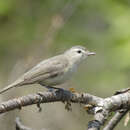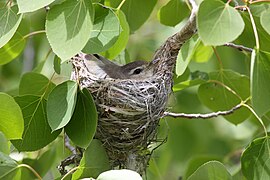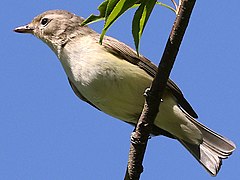en
names in breadcrumbs


Vireo gilvus is primarily an insectivore but will also consume spiders and berries in the fall and winter. They utilize a hover and glean feeding strategy, and capture nearly all of their food from peripheral leaves of trees or shrubs. Prey items include caterpillars and pupae of butterflies and moths (Lepidoptera), true bugs (Hemiptera), ladybug beetles (Coccinellidae), beetles (Coleoptera), as well as spiders (Arachnida). Non-insect items consumed include elderberries and poison oak berries.
Animal Foods: insects; terrestrial non-insect arthropods
Plant Foods: fruit
Primary Diet: carnivore (Insectivore )
Currently there have been no observations of adult or nest predation, though it is known to occur. Certain bird species are heavily mobbed by Vireo gilvus and are presumed to be predators. These species include Steller’s jays, western scrub-jays, blue jays and common grackles. Western mammalian predators include red squirrels and western gray squirrels. Their dull, olive-gray coloration likely serves as camouflage in the tree canopy.
Known Predators:
Anti-predator Adaptations: cryptic
Vireo gilvus is a smaller vireo, measuring 14 cm in length, 21.6 cm from wingtip to wingtip and weighing in at 12 g. They are overall olive-gray above, with a gray crown that contrasts only slightly with their olive-gray backs. Like many vireos they feature a white supercilium and gray eyestripe. The eyestripe and lores for this species are a pale gray which gives them a "blank-faced" look that distinguishes them from other, more boldly patterned vireos. The flanks and sides are a pale yellow, while the throat, breast and belly are nearly white. Beaks and legs are dark gray to black in color. This species exhibits no sexual dimorphism or distinctive juvenile plumage.
Average mass: 12.0 g.
Average length: 14.0 cm.
Average wingspan: 21.6 cm.
Other Physical Features: endothermic ; homoiothermic; bilateral symmetry
Sexual Dimorphism: sexes alike
The longest-lived Vireo gilvus individual was an adult banded in California and recaptured 13 years later. Adult annual survivorship estimates range from 50 to 83%. Exact causes of mortality are unknown but may include brood parasitism by brown-headed cowbirds, nest depredation, or decline in habitat quality.
Range lifespan
Status: wild: 13 (high) years.
Vireo gilvus prefers to breed in deciduous or mixed deciduous-coniferous woodlands with adequate canopy openings. Forested riversides and thickets are also potential nesting habitats. They occasionally inhabit young successional stands. They may also be found in urban parks, gardens, orchards or hedgerows. During the non-breeding season Vireo gilvus inhabits a wider range of habitats including second growth forests, plantations, oak forests, and coniferous forests. They are common in shade-grown coffee plantations which retain native canopy trees and shrubs. During migration, common stopover sites include deciduous forest, shrubby habitats, and scrub forests in the southwest. Throughout all seasons, Vireo gilvus avoids boreal or pine dominated habitats. They inhabit elevations of up to 3,000 m.
Range elevation: 3,000 (high) m.
Habitat Regions: temperate ; tropical ; terrestrial
Terrestrial Biomes: forest ; scrub forest
Other Habitat Features: urban ; agricultural ; riparian
Vireo gilvus, or warbling vireos, inhabit the Nearctic and Neotropical regions. This species breeds across nearly the entire United States, excluding the southeast region. The breeding range reaches north to include the southwest Canadian provinces of British Columbia, Alberta, Saskatchewan, and the southwest corner of Manitoba. They also breed in the southern portions of the Northwest Territories, Ontario, Quebec, and New Brunswick. Few populations breed in Mexico but are restricted to the Sierre Madre Occidental region. Vireo gilvus is a migratory species that overwinters in Central America from Mexico to the northern edges of Nicaragua.
Biogeographic Regions: nearctic (Native ); neotropical (Native )
Vireo gilvus is primarily an insectivore that likely impacts local prey populations. They are common hosts of brood parasitic brown-headed cowbirds and have not evolved any method to remove or destroy the foreign eggs. During fall and winter, these birds include berries in their diets, and may serve a small role as a local seed disperser. One individual has been reported to have have been captured with feather mites of the genus Proctophyllodes.
Commensal/Parasitic Species:
Vireo gilvus is primarily an insectivore, which may serve to reduce pest populations.
There are no known adverse effects of warbling vireos on humans.
Vireo gilvus is of least concern to the IUCN Red List as it has a large population size dispersed across a wide geographic range. As migratory birds, they are protected under the United States Migratory Bird Act. This species prefers forested habitats with significant portions of canopy openings and may thrive as a result of careful selective harvesting by the logging industry. There is a minor concern with regards to the effect of brown-headed cowbird brood parasitism. Warbling vireos have not yet evolved a method to identify, remove or destroy cowbird eggs which results in low productivity and may cause future population declines. Another concern is pesticide application, as warbling vireo populations may become locally extinct after foraging and nesting trees are sprayed.
US Migratory Bird Act: protected
US Federal List: no special status
CITES: no special status
State of Michigan List: no special status
IUCN Red List of Threatened Species: least concern
Like all birds, Vireo gilvus perceives its environment through visual, auditory, chemical and tactile stimuli. Vocal communications include male territorial song, courtship call, and a variety of contact, begging, and warning calls. The typical song is mnemonically described as "If I see you, I will seize you, and I'll squeeze you 'til you squirt!". Compared to other vireos, this call is undulating and more connected with an overall warbling quality. Calls are used between mates to locate each other, as well as warn of nearby predators. Pairs also use body postures to communicate during courtship. Male courtship begins with an aerial chase of the female which is followed by a stationary interaction where the male fans his tail and turns his body back and forth. The female responds with wing-quivering and will eventually peck at the male's beak when he approaches.
Communication Channels: visual ; tactile ; acoustic
Perception Channels: visual ; tactile ; acoustic ; chemical
Vireo gilvus is a monogamous species, but it is unknown if there is mate or site fidelity. Pair formation likely occurs during migration, as most pairs have already formed by the time they arrive on the breeding grounds. Courtship displays generally begin with males engaging females in a chase flight. Afterward, the male may give courtship calls while fanning his tail and moving his body from side to side, facing the female. Females respond with wing-quivering, and when the male approaches she will strike her bill against his. Some mate feeding has been observed during migration as well. Once pairs have formed, the two individuals will both sing courtship calls while constructing the nest together. No reports of mate defense currently exist.
Mating System: monogamous
In migratory populations, most warbling vireos arrive on the breeding grounds from mid-April to Mid-May and most have already formed pairs. Nest construction begins 2 to 7 days after arrival or pair formation on the breeding grounds. Nests are built by both males and females (though more-so by females) and are typically located high in the canopy, but height can range from 1 to 37 m. Like most vireos, they form a deep, hanging cup secured in a forked branch. Construction lasts 6 to 7 days and pairs incorporate leaves, grass, bark strips, pine needles, feathers or hair into the nest. Females lay an average clutch size of 4, white eggs which are spotted with brown or black. Eggs measure 19 mm in length. Incubation lasts 12 days on average, and the young fledge after 13 to 14 days. Parents continue to feed their fledglings for at least 2 weeks post-fledge, but exact independence date is unknown. Age at reproductive maturity is unknown but is presumed to be approximately 10 months or during an individual's first spring. In locations with long breeding seasons, two broods have been reported.
Breeding interval: Warbling vireos typically breed once yearly, but may produce two broods in locations with long breeding seasons.
Breeding season: Warbling vireos breed from mid-April through early August.
Range eggs per season: 3 to 5.
Average time to hatching: 12 days.
Range fledging age: 13 to 14 days.
Range time to independence: 14 (low) days.
Average age at sexual or reproductive maturity (female): 10 months.
Average age at sexual or reproductive maturity (male): 10 months.
Key Reproductive Features: iteroparous ; seasonal breeding ; gonochoric/gonochoristic/dioecious (sexes separate); sexual ; oviparous
Vireo gilvus females select a suitable nesting site and perform most of the nest construction. Once the nest is completed and eggs have been laid, both males and females take turns incubating the clutch though females perform most of the incubation as well. After hatching, the altricial young require constant feeding and brooding provided by both parents, although females more-so than males. Parents take turns watching over the nestlings and foraging for food, making sure that one parent is tending the brood at all times. Both parents remove fecal sacs from the nest, which likely reduces risk of disease or predation. Once the hatchlings fledge, both parents continue to feed and care for the young for an additional two weeks.
Parental Investment: altricial ; male parental care ; female parental care ; pre-fertilization (Provisioning, Protecting: Male, Female); pre-hatching/birth (Provisioning: Male, Female, Protecting: Male, Female); pre-weaning/fledging (Provisioning: Male, Female, Protecting: Male, Female); pre-independence (Provisioning: Male, Female, Protecting: Male, Female)
A medium-sized (5 inches) vireo, the Warbling Vireo is most easily identified by its plain brown-gray upperparts and wings, pale breast, and faint white eye-stripes. This species may be separated from the Red-eyed Vireo (Vireo olivaceus), which also has a pale breast and plain back, by that species’ brighter eye-stripes. Male and female Warbling Vireos are similar to one another in all seasons. The Warbling Vireo breeds across the northern United States and southern Canada. In the west, this species’ range extends southward at higher elevations as far as central Mexico. Warbling Vireos breeding in the U.S. and Canada spend the winter from central Mexico south to northern Central America, while populations breeding in central Mexico migrate short distances, if at all. Warbling Vireos breed in a variety of deciduous or mixed deciduous and evergreen woodland habitats. During the winter, this species may be found in a variety of semi-open habitats around tropical forests. Warbling Vireos primarily eat small insects, but also eat small quantities of fruits and berries during the winter. In appropriate habitat, Warbling Vireos may be seen foraging for food on leaves and branches in the tree canopy. Birdwatchers may also listen for this species’ song, a series of fluty notes more reminiscent of a warbler than a vireo. Warbling Vireos are primarily active during the day, but, like many migratory songbirds, this species migrates at night.
A medium-sized (5 inches) vireo, the Warbling Vireo is most easily identified by its plain brown-gray upperparts and wings, pale breast, and faint white eye-stripes. This species may be separated from the Red-eyed Vireo (Vireo olivaceus), which also has a pale breast and plain back, by that species’ brighter eye-stripes. Male and female Warbling Vireos are similar to one another in all seasons. The Warbling Vireo breeds across the northern United States and southern Canada. In the west, this species’ range extends southward at higher elevations as far as central Mexico. Warbling Vireos breeding in the U.S. and Canada spend the winter from central Mexico south to northern Central America, while populations breeding in central Mexico migrate short distances, if at all. Warbling Vireos breed in a variety of deciduous or mixed deciduous and evergreen woodland habitats. During the winter, this species may be found in a variety of semi-open habitats around tropical forests. Warbling Vireos primarily eat small insects, but also eat small quantities of fruits and berries during the winter. In appropriate habitat, Warbling Vireos may be seen foraging for food on leaves and branches in the tree canopy. Birdwatchers may also listen for this species’ song, a series of fluty notes more reminiscent of a warbler than a vireo. Warbling Vireos are primarily active during the day, but, like many migratory songbirds, this species migrates at night.

The warbling vireo (Vireo gilvus) is a small North American songbird.
Its breeding habitat is open deciduous and mixed woods from Alaska to Mexico and the Florida Panhandle. It often nests in widely spaced trees, often cottonwood or aspen, along streams or rivers. It migrates to Mexico and Central America.
Measurements:[2]
They are mainly olive-grey on the head and upperparts with white underparts; they have brown eyes and the front of the face is light. There is a white supercilium. They have thick blue-grey legs and a stout bill. Western birds are generally smaller and have darker grey crowns.
Warbling vireos forage for insects in trees, hopping along branches and sometimes hovering. They also eat berries, especially before migration and in winter quarters, where they are – like other vireos – apparently quite fond of gumbo-limbo seeds, though they will not venture into human-modified habitat to get them.[3] They make a deep cup nest suspended from a tree branch or shrub, placed relatively high in the east and lower in the west. The male helps with incubation and may sing from the nest.
The warbling vireo's song is a cheerful warble, similar to that of the painted bunting and the purple finch. There are subtle differences in song between eastern and western birds, at least where the ranges meet in Alberta. Some authorities split the eastern and western races of this species into separate species: The western warbling vireo, V. swainsoni, includes V. g. swainsoni, which breeds from southeastern Alaska and southwestern Northwest Territories to the Sierra San Pedro Mártir, Baja California, and V. g. brewsteri, which breeds from southern Idaho, Wyoming, and Montana to south-central Oaxaca. These two subspecies winter in Mexico. The swainsoni group also includes V. g. victoriae, an isolated population breeding in the Sierra de la Laguna, Baja California Sur, and migrating to unknown wintering grounds.[4]
The eastern warbling vireo, V. gilvus, breeds from central Alberta and northern Montana east and south through most of the United States and parts of southern Canada, outside the range of the previous group. It winters south of the Isthmus of Tehuantepec from south-central Chiapas to Nicaragua. It completes its autumn molt on the breeding grounds, while the swainsonii group completes it after leaving.[4]
The brown-capped vireo (Vireo leucophrys), resident in Central America and northern South America, is sometimes considered conspecific with the warbling vireo.
Vireo singing Ruby Mountains, Nevada
On nest, Ruby Mountains, Nevada
Perched, Illinois
 Song Song of V. gilvus gilvus at Grey Cloud Dunes SNA, Washington, MN, USA Problems playing this file? See media help.
Song Song of V. gilvus gilvus at Grey Cloud Dunes SNA, Washington, MN, USA Problems playing this file? See media help. The warbling vireo (Vireo gilvus) is a small North American songbird.
Its breeding habitat is open deciduous and mixed woods from Alaska to Mexico and the Florida Panhandle. It often nests in widely spaced trees, often cottonwood or aspen, along streams or rivers. It migrates to Mexico and Central America.
Measurements:
Length: 4.7-5.1 in (12-13 cm) Weight: 0.3-0.6 oz (10-16 g) Wingspan: 8.7 in (22 cm)They are mainly olive-grey on the head and upperparts with white underparts; they have brown eyes and the front of the face is light. There is a white supercilium. They have thick blue-grey legs and a stout bill. Western birds are generally smaller and have darker grey crowns.
Warbling vireos forage for insects in trees, hopping along branches and sometimes hovering. They also eat berries, especially before migration and in winter quarters, where they are – like other vireos – apparently quite fond of gumbo-limbo seeds, though they will not venture into human-modified habitat to get them. They make a deep cup nest suspended from a tree branch or shrub, placed relatively high in the east and lower in the west. The male helps with incubation and may sing from the nest.
The warbling vireo's song is a cheerful warble, similar to that of the painted bunting and the purple finch. There are subtle differences in song between eastern and western birds, at least where the ranges meet in Alberta. Some authorities split the eastern and western races of this species into separate species: The western warbling vireo, V. swainsoni, includes V. g. swainsoni, which breeds from southeastern Alaska and southwestern Northwest Territories to the Sierra San Pedro Mártir, Baja California, and V. g. brewsteri, which breeds from southern Idaho, Wyoming, and Montana to south-central Oaxaca. These two subspecies winter in Mexico. The swainsoni group also includes V. g. victoriae, an isolated population breeding in the Sierra de la Laguna, Baja California Sur, and migrating to unknown wintering grounds.
The eastern warbling vireo, V. gilvus, breeds from central Alberta and northern Montana east and south through most of the United States and parts of southern Canada, outside the range of the previous group. It winters south of the Isthmus of Tehuantepec from south-central Chiapas to Nicaragua. It completes its autumn molt on the breeding grounds, while the swainsonii group completes it after leaving.
The brown-capped vireo (Vireo leucophrys), resident in Central America and northern South America, is sometimes considered conspecific with the warbling vireo.

Vireo singing Ruby Mountains, Nevada

On nest, Ruby Mountains, Nevada

Perched, Illinois